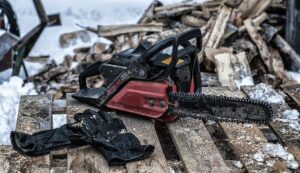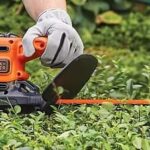As an Amazon Associate, this site earns commissions from qualifying purchases. For more information click here.
A rarely used and poorly maintained chainsaw will get rusty at some point, but do not let it worry you. With the following methods you can remove the rust and your chainsaw will look as good as new. For the best results, you should apply any of these solutions before rust spreads all over the blade and other parts.
Spray WD-40 on the rusty parts, let it dry for 24 hours and wipe it with a brush. Another option is to dip the rusted chainsaw parts in white vinegar for at least 12 hours. Brush the surface and any remaining rust should come off.
The blade, chain and other metallic parts are the most vulnerable to rust and corrosion. Before trying any of the methods below, remove the corroded components from the chainsaw. This way you don’t risk spilling any of the solution on the unaffected areas
Method 1: Vinegar
Vinegar is a versatile solution for removing all kinds of stains, marks, grease and even heavily rusted objects. In this example we will use vinegar to remove rust on a chainsaw blade, but you can use this for bolts, chains or any other chainsaw part with corrosion.
You will need:
- White vinegar
- Water
- Mixing bowl
- Aluminum foil
- Steel brush
- Paper towels
- Rags
Instructions
Step 1. If there is a lot of rust on the blade, pour the vinegar and water in a large bowl and leave the blade in there for 8-12 hours.
Step 2. Remove the blade from the container. Most if not all the rust will have disappeared. Repeat the process if necessary. Wash the blade in running water and dry it with a rag or cloth.
If the rusted blade is too large for your container, you have to do it little by little. Prepare a 1:1 solution of white vinegar and water as you did in step 1.
Step 3. Fold the aluminum foil and dampen it with the vinegar. Brush the foil onto the rusty blade. Leave it there overnight.
Step 4. If there is still rust, prepare another vinegar solution. Dip a steel brush into it and use it to wipe the rust away. Another option is to soak rags with the vinegar and wipe it on the blade. If there is a lot of rust, tie the cloth around the blade and leave it for several hours.
Method 2: Baking Soda
Another method you can use is baking soda. It is very easy and works well for light rust on saw blades and other metal parts.
You will need:
- Baking soda
- Baking powder
- Mixing bowl
- Water
- Toothbrush
- Cleaning rags
Instructions
Step 1. Combine the baking soda and baking powder in a bowl. The ratio should be 1:1. Mix until it turns into a paste-like consistency.
Step 2. Dip a toothbrush or sponge into the paste. Apply large amounts on the rusted areas of your chainsaw. Leave the paste on for at least 90 minutes.
Step 3. Brush the rust away. If there is only a small amount of rust this should not take long. But if the blade is heavily rusted, you might have to use a steel brush. You have to be careful because the brush might scratch the blade.
Step 4. Once the rust is gone, wash the blade in water. Wipe it dry with a cloth or cleaning rag. With your chainsaw blade looking brand new, you can protect it with a lubricant. Remember to warm up the chainsaw before cutting.

Method 3: Salt and Lemon
Just like vinegar, lemon is often used to remove stubborn stains and odors. But combined with salt it becomes an effective method of removing rust from metal objects. This technique works best with light amounts of rust.
You will need:
- Salt
- Lemon
- Mixing bowl
- Wet sponge
- Brush
- Beeswax
Instructions
Step 1. Add 3 parts lemon for every 1 part salt in the bowl. Mix until you get the consistency of paste.
Step 2. Apply the paste on the rusted chainsaw parts. Leave it there for at least 45 minutes. That will give the lemon salt mix enough time to soak in the rust.
Step 3. After 45 minutes, wipe the surface with a sponge. Wipe the paste off with a dry cloth.
Step 4. At this point you may apply some beeswax over the now rust-free parts. Leave it there for a few hours then remove it.
Step 5. Repeat steps 1 to 4 if there is still rust. If there is none, wash the blade or chain with water. Let it dry.
Method 4: WD-40
If you use a chainsaw to cut trees it will be heavily exposed to the elements. This makes it vulnerable to rust and corrosion. With WD-40 you can say goodbye to rust on your chainsaw and other tools.
You will need:
- WD-40
- Wire brush
Instructions
Step 1. Spray the WD-40 on every area of your chainsaw with rust. If there is only rust on the screws and blade, remove them first. This way you do not get any of the spray on the rest of the tool.
Step 2. If there is a lot of rust, you may want to apply multiple coats. Wait 10 minutes after applying the first coat before going on to the next coating.
Step 3. When you are done spraying, let the WD-40 dry for 24 hours.
Step 4. Brush away any remaining rust you see. Dip the brush in more WD-40 if necessary.
If the blade is heavily corroded, put the whole thing in a large container filled with WD-40. Leave it there overnight and it should be rust-free by morning.
Note: there are a lot of chemicals and cleansers you can use, including Maxtite oxalic acid. You need 250ml hot water and 25ml oxalic acid and leave it on the rusty areas for 30 minutes. Wipe with a rag afterwards and wash with water.
While oxalic acid can be effective, you need to exercise caution. Wear safety goggles, gloves and a mask over your mouth and nose. You must not inhale it under any circumstances.
Tips for Removing Chainsaw Rust
Any of the methods given above should work, whether there is a small or large amount of rust. But you can make things even easier by keeping these guidelines in mind.
Clean regularly. To put it simply, your chainsaw –and any garden tool- has to be cleaned on a regular basis. Wipe it clean after each use. In fact you should still clean your chainsaw even if it is in storage. Letting it gather dust is going to affect its performance sooner than later.
When you are done cleaning the chainsaw, store it in a dry location. Make sure you lubricate the blades, the engine and all other essential parts. Knowing how to properly store a chainsaw is one of the keys to making certain it does not rust.
Remove the rusty chainsaw parts. If only the blade is rusty, remove it. This way you can work on the blade without having to carry the whole saw. If the rust is on the screws and bolts, remove them so you do not spill any cleansing mixture on the rest.
Just add water. With the vinegar and baking soda treatment, a little water is enough. Too much will dilute the mix and lose potency. In the case of baking soda and powder for instance, you just want to add enough water to make a thick paste.
Be thorough. Rust can sometimes be hard to reach. Use a long, thin brush and scrub them off. If you immersed a rusty blade in a cleaning solution, some areas might still end up with rust. That is where you should use a brush.
You should also follow any maintenance advice offered in the owner’s manual. There are many types of chainsaws and some models require specific maintenance. By following these guidelines, you can avoid rust from settling in.

I love the outdoors and all the tools for maintaining gardens, yards and lawns. The only thing I am more passionate about is sharing what I know about garden and outdoor equipment.


